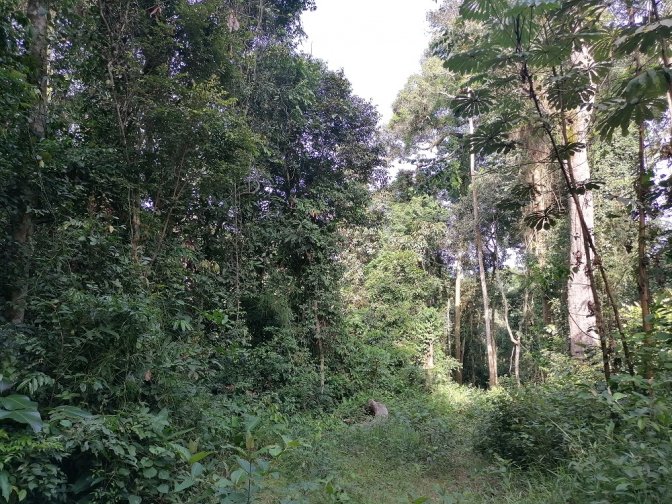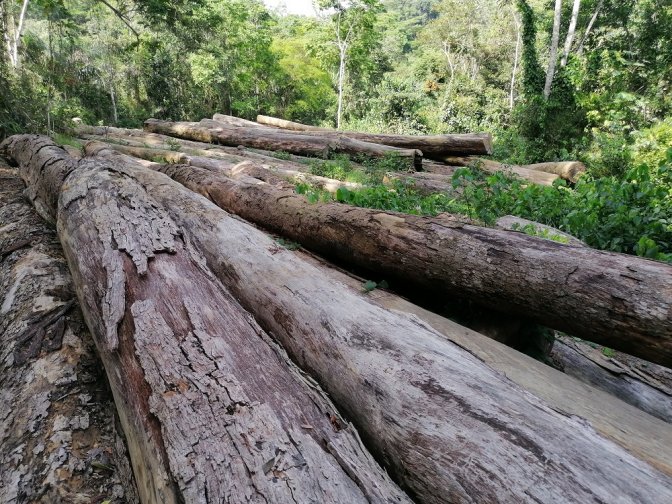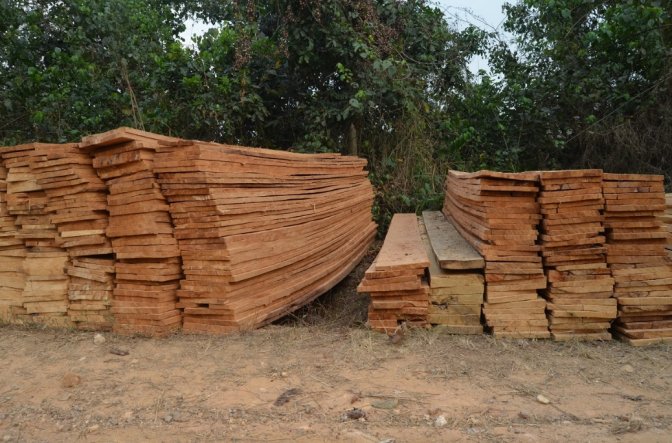Home / Guinean forests / Threats / Industrial logging
Industrial logging
Selective logging of timber is carried out by industrial companies, often over large areas using heavy machinery, in permanent production forests, and on the basis of a forest concession contract and most often a forest management plan agreed with the State. It targets so-called "noble" species, which have a high industrial quality and are present in low density per hectare.
The logging activity consists in particular of felling, processing and transporting the wood. In the past, clearing was widely practised In tropical forests. This has since been replaced by "selective logging", which targets trees for commercial purposes.
According to Global Forest Watch (2019 edition), logging is responsible for only a fraction of forest cover loss (a few hundred hectares per year) in countries such as Côte d’Ivoire, Ghana, Guinea, Liberia, Nigeria or Sierra Leone.
Nevertheless, industrial logging, whether legal or illegal, plays a role in the degradation of tropical forests.
Many tree species are exploited in Guinean forests, including:
- African mahogany (Khaya ivorensis)
- Upas tree (Antiaris Africana)
- Azobé (Lophira alata)
- African whitewood (Triplochiton scleroxylon)
- Bilinga (Nauclea diderricgii)
- Dabéma (Piptadeniastrum africanum)
- Dibetou or African walnut (Lovoa trichiliodes)
- Fraké, Limba (Terminalia superba)
- Framiré or Idigbo (Terminalia ivorensis)
- Iroko (Milicia excelsa)
- Kapokier, Fromager (Ceiba pentandra)
- Niangon (Heritiera utilis)
- Rikio (Uapaca guinnensis)
- Sapelli (Entandrophragma cylindricum)
- Sipo (Entandrophragma utile)
- Tali (Erythrophleum ivorense, Erythrophleum suaveolens)
- White Tiama (Entandrophragma angolense)
- Also in plantations such as Teak (Tectona grandis).
Here are some indications of the volumes produced, imported, exported and for the domestic market. Only Nigeria is ranked among the top producers of forest products globally (FAO, 2019).
(thousand m3)
| Volume produced | Volume imported | Domestic consumption | Volume exported | |
|---|---|---|---|---|
| Nigeria (FAO 2021, data 2017) | ||||
| Logs (industrial roundwood) | 10 002 | 1 | 9 418 | 584 |
| Sawn timber | 2 002 | 0 | 1 947 | 55 |
| Veneer | 2 | 2 | 1 | 1 |
| Plywood | 56 | 144 | 53 | 3 |
| Ghana (ITTO 2019, data 2017) | ||||
| Logs (industrial roundwood) | 2 450 | 10 | 2 014 | 446 |
| Sawn timber | 534 | 4 | 449 | 89 |
| Veneer | 262 | 0 | 246 | 16 |
| Plywood | 180 | 16 | 172 | 24 |
| Côte d’Ivoire (ITTO 2019, data 2017) | ||||
| Logs (industrial roundwood) | 2 415 | 1 | 2 388 | 28 |
| Sawn timber | 872 | 0 | 747 | 127 |
| Veneer | 245 | 2 | 148 | 97 |
| Plywood | 106 | 4 | 77 | 33 |
| Liberia (ITTO 2019, data 2017) | ||||
| Logs (industrial roundwood) | 501 | 0 | 365 | 136 |
| Sawn timber | 133 | 1 | 132 | 1 |
| Veneer | 0 | 0 | 0 | 0 |
| Plywood | 0 | 7 | 7 | 0 |
| Sierra Leone (FAO 2021, data 2017) | ||||
| Logs (industrial roundwood) | 124 | 0 | 78 | 46 |
| Sawn timber | 30 | 0 | 10 | 20 |
| Veneer | 1 | 0 | 1 | 0 |
| Plywood | 0 | 3 | 0 | 0 |
Industrial logging in the main countries covered by Guinean forests (volumes produced, imported, exported and for the domestic market).Sources :
- The Timber Trade Portal: https://www.timbertradeportal.com/en
- ITTO database: https://www.itto.int/biennal_review/
- FAO Stat – Forestry production and trade: https://www.fao.org/faostat/en/#data/FO
The table below on export markets shows the predominance of China, a market that makes very few requirements in terms of timber origin, in the import of timber from Guinean forests.
| Côte d’Ivoire | Ghana | Liberia | Nigeria | Sierra Leone |
| China | China | China | Spain | China |
| France | USA | Thailand | China | Poland |
| Portugal | Turquey | Sauth Africa | Israel | France |
| Turquey | South Africa | Brazil | Saudi Arabia | Austria |
| Austria | Chile | Spain | Ghana | Senegal |
Source : Trade statistics for international business development : https://www.trademap.org/
Industrial logging has a direct impact on Guinean forests, mainly through
- Damage from felling and other clearings caused by roads and other infrastructure which result in a loss of forest area and a decrease in biomass;
- Habitat fragmentation caused by the creation of access roads into the forest, which can form a barrier for certain animal species;
- Noise and other disturbance, which may, for example, cause certain primates to flee and bring them into conflict with neighbouring territorial groups;
- Change in the floristic composition of the forest stand (trees, vegetation and fauna), through the selective removal of harvested species and opening up of the forest cover, which leads to the growth of new species linked to the arrival of light on the ground;
- Soil erosion, sediment accumulation and pollution (hydrocarbons and chemicals);
- The reduction in the number of available seeds, and loss of genetic diversity through the felling of the main, mature and often best-formed trees, which are seed dispersers for these species.
Focus on wildlife
Some plant components play a key role for wildlife (fruit, which is a key resource in dry seasons, leaves) and some animal communities are particularly reliant on the forest ecosystem (frugivores, folivores, insectivores). Changing the structure and composition of forest stands can lead to changes in the availability of food resources, to the scarcity or disappearance of a key resource, or to the creation of interactions between species or individuals (predation, territoriality).

Industrial logging indirectly impacts Guinean forests, mainly through
- The increase in human populations in the forest (workers, their families and other populations linked to local economic development), which increases the pressure on woodlands around the base camp due to agricultural deforestation, and on wildlife due to hunting in the forest;
- Heightened risks to health due to the increased contact between humans and wildlife and between domestic animals and wildlife, which favours the spread of zoonoses (contagious diseases that can be transmitted from animals to humans in natural circumstances);
- Increased access both to remote forests and to means of transport, which facilitates hunting and trade in wild meat in unused forests;
- The creation of demand for food, with living areas and staff in the forest forming a local market for bushmeat supplied by :
- local people, who traditionally hunted for their own consumption, developing this a lucrative activity carried out intensively with modern and often illegal weapons;
- forestry company employees who hunt for their own consumption;
- sponsors and traders of bushmeat.
- -* The creation of direct links with urban areas, which facilitates the provision of bushmeat on a wide scale through illegal and mafia-like channels structured around the corruption of officials.
- Central Africa’s experience in this area has led to the emergence of wildlife management initiatives within forest concessions, an overview of which can be found in:
- Haurez B., Fonteyn D., Toint S., Bracke C., Doucet J.-L., Daïnou K., Kéhou S., Vermeulen C. (2020). Development and implementation of a wildlife management plan. A technical guide for managers of Central African production forests. Gembloux, Belgium. Presses agronomiques de Gembloux: https://orbi.uliege.be/handle/2268/253115
Artisanal logging ... a little known and underestimated sector
Artisanal logging can be defined as a set of activities carried out by small-scale independent loggers, with or without a licence, with the main aim of selling sawn timber on the domestic market or in certain neighbouring countries.
This sector is not described in the Guinean forests, whereas it is documented in some Central African countries, notably the Democratic Republic of Congo (DRC).
Artisanal logging is often seen as an activity that consists of misappropriation of legal logging permits. It remains largely informal due to legal loopholes.
In the DRC, the production of artisanal sawn timber is 13 times greater than formal timber production. An increase in artisanal sawmilling has been observed in recent years due to the increase in the size of the urban population and a relative increase in the purchasing power of certain urban classes.
Les populations locales sont des bénéficiaires majeurs du sciage artisanal. Par la vente des arbres, les salaires, les profits en milieu rural et les paiements des cahiers des charges.
Le sciage artisanal à petite échelle crée aujourd’hui de nombreux emplois. Au total, en regroupant les activités rurales et urbaines, le secteur du sciage artisanal offre au moins 25 000 emplois directs en RDC.
L’administration capterait un pourcentage des revenus nets générés par la filière, mais une partie probablement importante des taxes n’est pas reversée au Trésor Public mais est directement captée par des représentants des administrations.
Local people are major beneficiaries of artisanal sawmilling, through the sale of trees, salaries, profits in rural areas and payments for specifications.
Today, small-scale artisanal sawmilling creates many jobs. In total, taking rural and urban activities together, the sector provides at least 25 000 direct jobs in the DRC.
Public administrations collect a share of net revenues generated by the sector, but it is likely that a large proportion of taxes is not paid to the Treasury but rather directly collected by representatives of public bodies.



